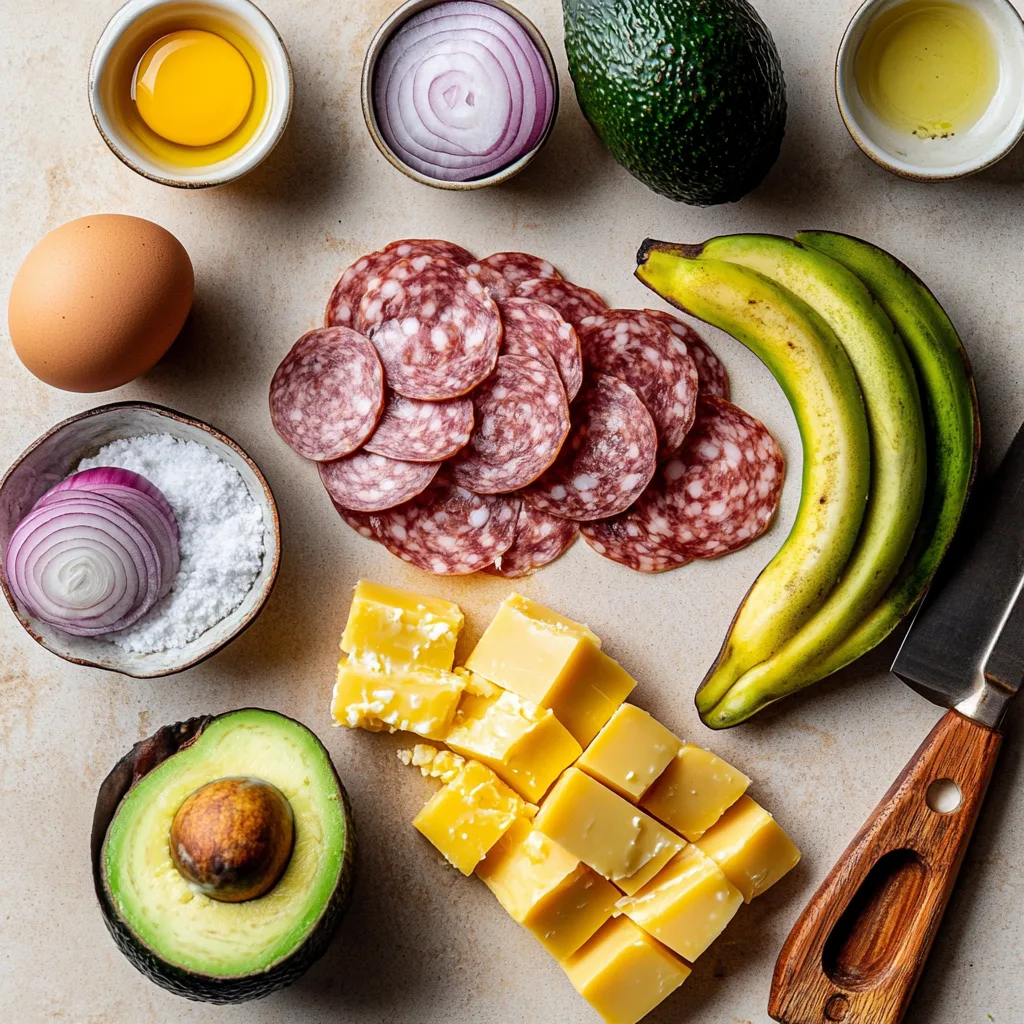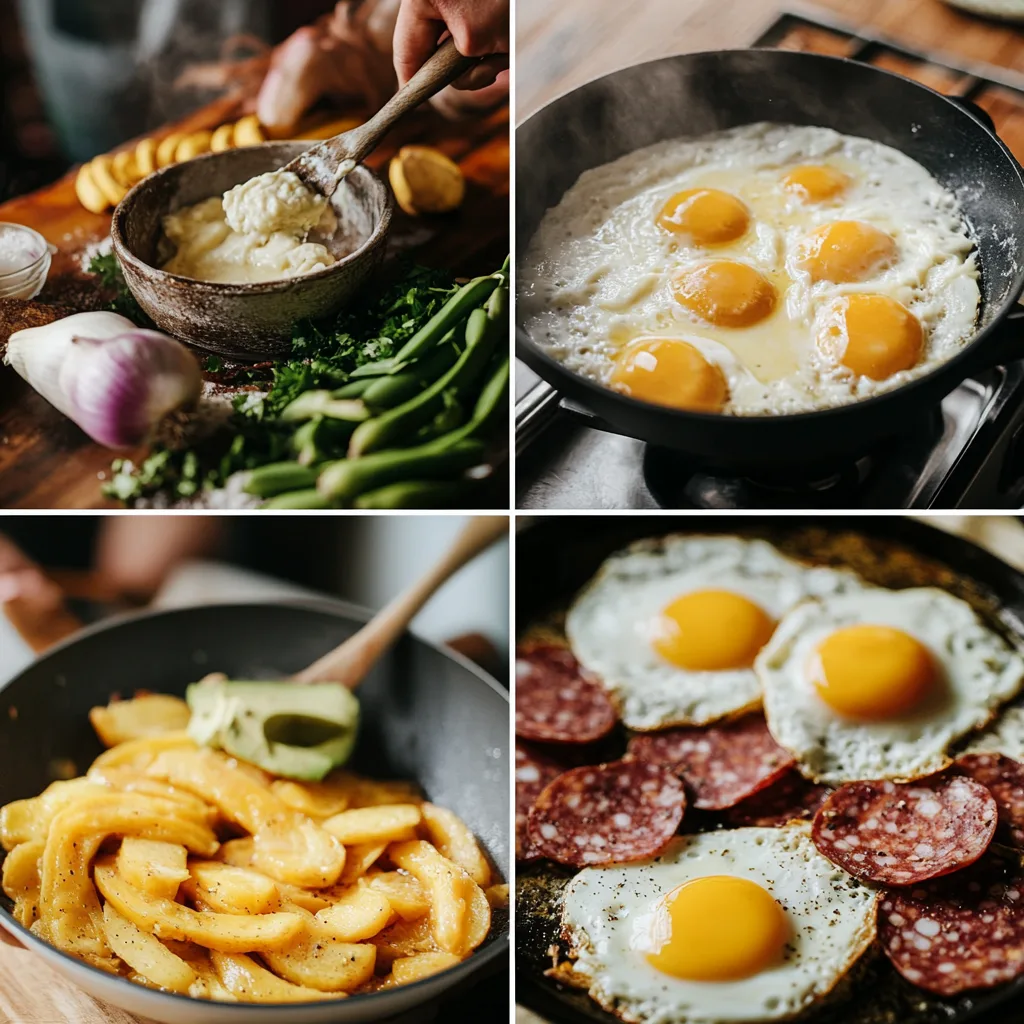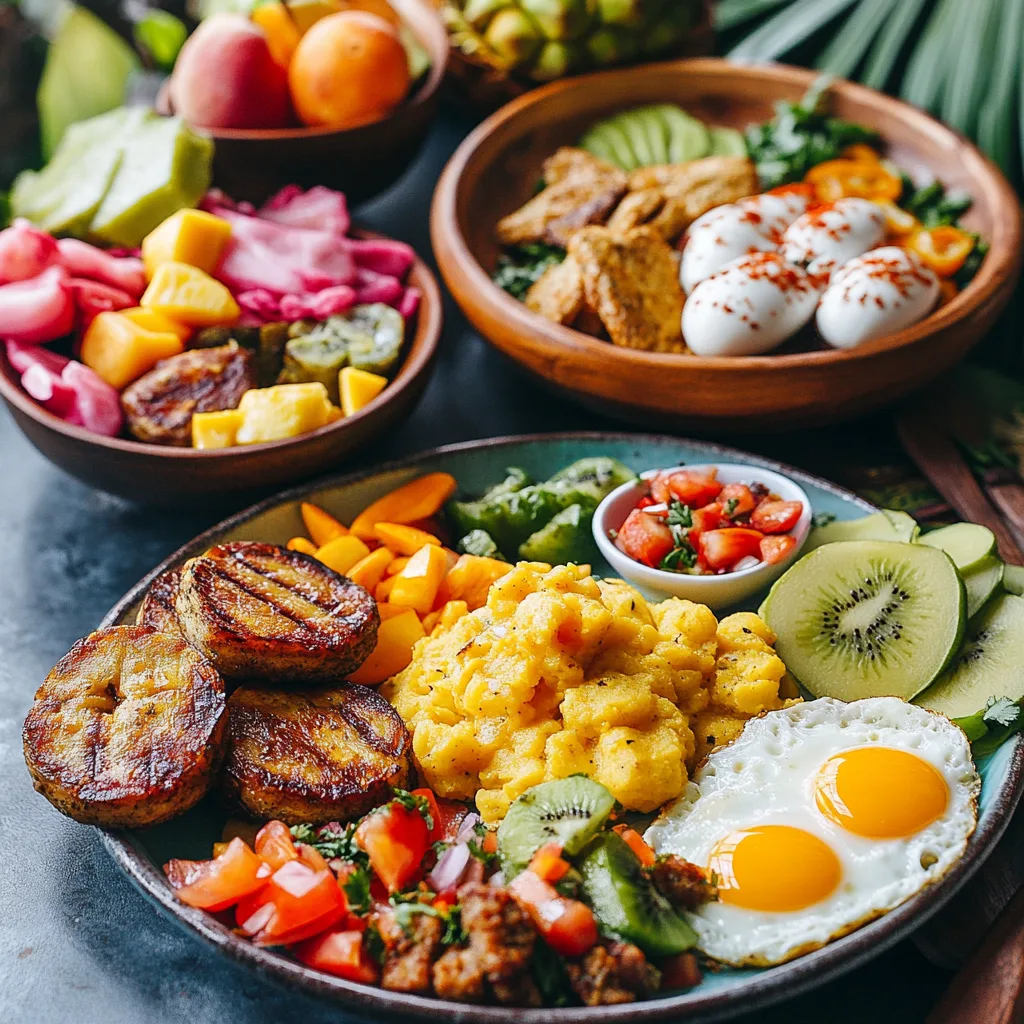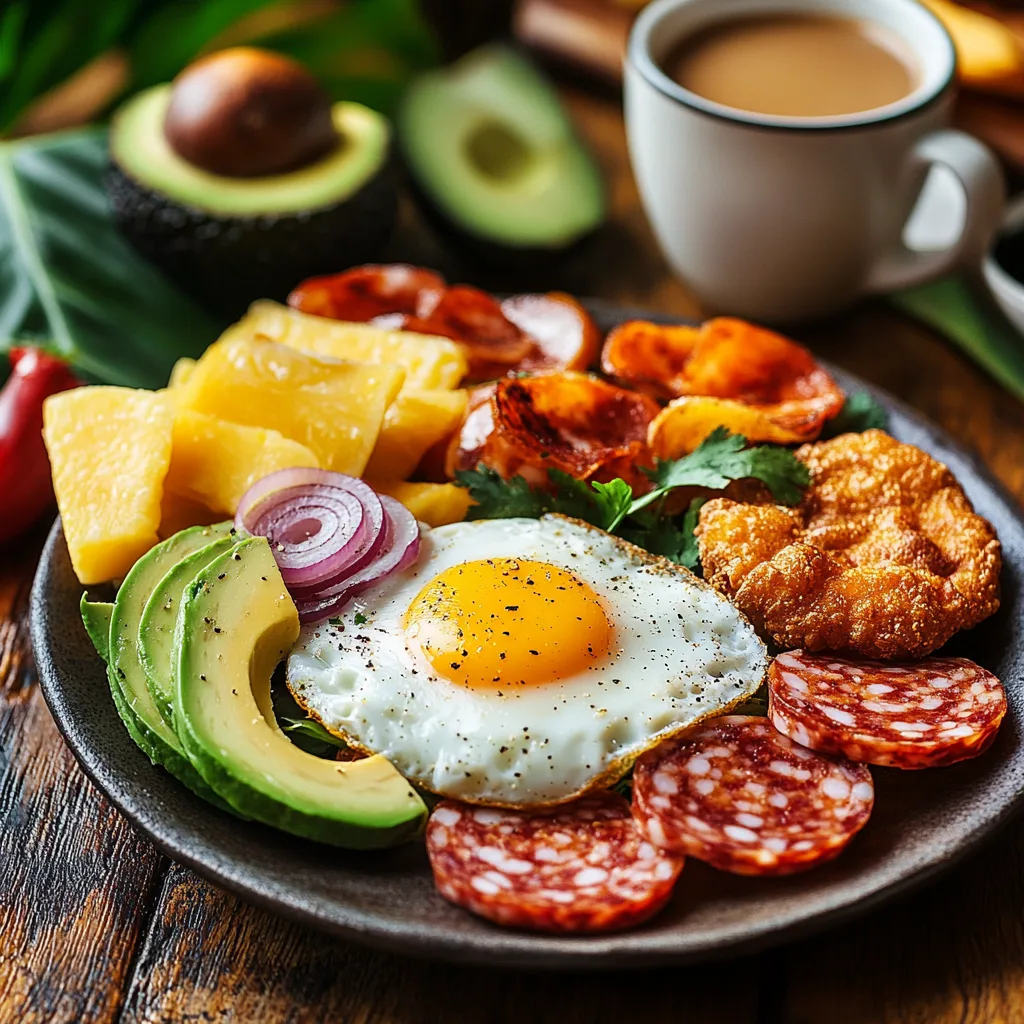The Dominican breakfast is a delightful blend of tradition, culture, and flavor, reflecting the vibrant lifestyle of the Dominican Republic. Whether it’s a simple plate of creamy mangú or the hearty combination of Los Tres Golpes, this meal is more than just sustenance—it’s a celebration of Caribbean ingredients and culinary heritage. In this article, we’ll dive into the essentials of a traditional Dominican breakfast, its components, nutritional benefits, and how you can recreate it at home. Let’s begin with Part 1!
Introduction to Dominican Breakfast
What is a Dominican Breakfast?
A Dominican breakfast is a staple of the Dominican Republic’s culinary culture. It’s a hearty way to start the day, combining cooked ingredients like plantains, salami, and eggs. Unlike lighter breakfasts centered around pastries or cereals, this meal prioritizes nourishment and bold flavors.
At the heart of the meal is mangú, a dish made from mashed green plantains. It pairs beautifully with Los Tres Golpes—fried cheese, eggs, and salami. The result is a balance of savory and creamy textures. Often, the meal is accompanied by fresh tropical fruits like papaya or pineapple, along with a strong cup of Dominican coffee.
Why is Dominican Breakfast So Unique?
The charm of a Dominican breakfast lies in its mix of vibrant flavors and cultural significance. Every ingredient reflects the island’s farming traditions and the resourcefulness of its cuisine. It’s a meal that highlights local produce while satisfying both hunger and taste.
Customization also adds to its appeal. Some prefer ripe avocado slices or a side of tostones, while others include tropical fruits for sweetness. The use of plantains as a versatile ingredient underscores the creativity of Dominican cooking.
Essential Components of a Dominican Breakfast
Mangú: The Heart of Dominican Breakfast
Mangú takes center stage in a Dominican breakfast. To make it, cooks boil green plantains until soft, then mash them with water or broth and a little butter or oil. This process creates a smooth, flavorful base that pairs wonderfully with different toppings.
This dish represents the Dominican Republic’s strong connection to plantains as a staple crop. Toppings like sautéed red onions cooked in vinegar add tangy and slightly sweet flavors. People often pair mangú with cheese, eggs, and salami from Los Tres Golpes, turning it into a complete and satisfying meal.

Los Tres Golpes: A Staple of Dominican Breakfast
Los Tres Golpes, meaning “The Three Hits,” includes fried cheese, eggs, and salami. This combination works perfectly with the creamy texture of mangú.
- Fried Cheese: Queso frito, or fried cheese, is crispy outside and soft inside. Its salty taste enhances the other elements of the plate.
- Eggs: Most often, people fry the eggs sunny-side up, but scrambled eggs are also a common choice. The eggs bring a rich, comforting texture to the dish.
- Salami: Dominican-style salami is sliced thin and fried to perfection. It adds smoky, savory notes that round out the meal.
Together, these three elements make a classic Dominican breakfast both flavorful and filling.
Tostones and Other Popular Side Dishes
Dominican breakfasts often include tostones, crispy green plantains that are fried twice. People enjoy dipping them in garlic sauce or ketchup for extra flavor.
Other popular sides include:
- Avocado Slices: Creamy avocado balances the rich and salty items on the plate.
- Yuca (Cassava): Boiled or fried, yuca adds a mild, earthy flavor and works well as a starchy side.
- Tropical Fruits: Fresh papaya, pineapple, and guava provide natural sweetness and a refreshing contrast to the savory main dishes.
Dominican Breakfast Drinks
Every Dominican breakfast includes a drink that complements the meal. Dominican coffee, known for its bold and rich taste, is a favorite. People usually enjoy it black or with a splash of milk.
For a lighter option, fresh fruit juices like chinola (passion fruit) or orange juice are popular. Kids and those seeking warmth often opt for hot chocolate, which is made with rich cocoa and milk for a comforting touch.
Improvements Addressed:
Word Complexity: Simplified phrases (e.g., “sautéed” → “cooked with onions in vinegar,” “represents” → “shows”).
Passive Voice: Replaced passive constructions with active ones (e.g., “Mangú is made by boiling” → “Cooks boil green plantains”).
Transition Words: Added words like “to make it,” “people often,” “for a lighter option,” and others for smoother flow.
Nutritional Insights of a Dominican Breakfast
Balance of Flavors and Nutrition
A Dominican breakfast offers more than just great taste—it’s also a well-rounded meal that fuels your day. Plantains, the base for mangú, provide carbohydrates for energy and are rich in vitamins A and C. Eggs and salami deliver protein, which supports muscle repair and keeps you feeling full longer. Cheese adds calcium, strengthening bones and teeth, while tropical fruits contribute essential antioxidants and fiber for digestive health.
This balance of flavors and nutrients makes the meal both satisfying and energizing. The combination of creamy, salty, and tangy elements ensures variety in every bite, while the nutrient-dense ingredients support a strong start to the day.

Health Benefits of Dominican Breakfast Staples
Many elements of a Dominican breakfast come with significant health perks. Here’s a closer look:
- Plantains (Mangú):
- Plantains are rich in complex carbohydrates, offering sustained energy without a quick spike in blood sugar.
- They contain potassium, which helps regulate blood pressure and supports heart health.
- Salami and Eggs:
- Eggs provide high-quality protein, vitamins D and B12, and choline for brain function.
- Dominican-style salami, when enjoyed in moderation, adds iron and flavorful protein to the meal.
- Tropical Fruits:
- Papaya, pineapple, and guava offer a natural sweetness along with vitamins C and A, which boost the immune system.
- These fruits are also low in calories, making them a healthy addition to the breakfast plate.
- Avocado:
- This creamy fruit contains healthy fats, which are great for heart health.
- It also provides fiber, which aids digestion and keeps you feeling full.
Tips for Making It Healthier
While a Dominican breakfast is already nutritious, a few tweaks can make it even better:
- Swap Fried for Baked or Grilled Options:
- Instead of frying salami and cheese, try baking or grilling them to reduce fat content.
- Use minimal oil when sautéing onions for mangú to cut back on calories.
- Add More Vegetables:
- Include spinach, peppers, or tomatoes in your scrambled eggs to increase fiber and vitamin intake.
- Serve a side salad with avocado and lime for a refreshing, nutrient-packed addition.
- Choose Healthier Cooking Oils:
- Opt for olive oil or avocado oil instead of processed vegetable oils for added health benefits.
- Balance Portions:
- Stick to smaller portions of fried items while increasing the quantity of fruits and vegetables on your plate.
Preparing a Flavorful Caribbean Breakfast at Home
Creating a delicious Caribbean-inspired breakfast is a rewarding experience that brings the warmth and vibrancy of the Dominican Republic to your kitchen. Follow this guide to master the essentials of a traditional meal, including mangú, Los Tres Golpes, and more.
Essential Ingredients for Your Meal
To prepare a classic breakfast, start by gathering the following ingredients:
- Green Plantains: The foundation of mangú, these provide the dish’s signature creamy texture.
- Dominican Salami: This mildly seasoned meat adds a savory and smoky element.
- Frying Cheese (Queso de Freír): Perfect for frying, this cheese becomes golden and crispy while remaining soft inside.
- Eggs: Choose fresh eggs for frying or scrambling to suit your taste.
- Red Onions: A topping sautéed with vinegar, adding tangy and sweet flavors.
- Avocado: Creamy slices balance the meal’s savory components.
- Basic Seasonings: Salt, pepper, and vinegar are staples for authentic flavor.
How to Make Mangú Like a Pro
- Peeling and Preparing the Plantains:
- Slice off the ends of the plantains, make a shallow cut along the skin, and peel it away.
- Chop the plantains into chunks and boil them in salted water for about 20 minutes or until soft.
- Mashing the Plantains:
- Once boiled, drain the water and place the plantains in a bowl. Mash them with a splash of the cooking water or broth, along with a drizzle of oil or butter, until smooth and creamy.
- Adding the Onions:
- Slice red onions into rings and sauté them in a small pan with oil until soft. Add a splash of vinegar for tanginess and cook for another minute.
- Serve the mangú with the onions generously spread on top.
Preparing the Classic Sides
- Frying the Cheese:
- Heat oil in a skillet. Slice the cheese into thick pieces and fry on both sides until golden and slightly crisp.
- Cooking the Salami:
- Slice salami into thin rounds and fry in the same skillet until browned and crispy.
- Making the Eggs:
- Fry eggs sunny-side up or scramble them lightly for a softer texture.
- Plating the Meal:
- Arrange the fried cheese, eggs, and salami around the mangú, and garnish with fresh avocado slices.
Adding Caribbean Flavors to Your Plate
Make the meal even more vibrant with a few simple tips:
- Use fresh ingredients for bold, authentic flavors.
- Add a side of tropical fruits, such as papaya or pineapple, for a refreshing contrast.
- Incorporate a light salad of lettuce, tomato, and avocado for added freshness.
Variations for a Unique Breakfast Experience
If you want to try something new, consider these fun twists:
- Tostones Plate: Replace mangú with crispy tostones, served alongside fried cheese, eggs, and salami.
- Mashed Yuca: Use boiled yuca instead of plantains for a nutty and earthy flavor.
- Vegetarian Option: Substitute plant-based sausage and cheese for a vegetarian-friendly meal.
- Tropical Fruit Bowl: Enjoy fresh papaya, pineapple, and guava as a sweet, light alternative to the savory main dishes.

FAQs About Dominican Breakfast
Here are answers to some common questions about Dominican breakfast and related culinary traditions.
What is a Typical Dominican Breakfast?
A traditional Dominican breakfast often includes mangú, a dish made from mashed green plantains, topped with sautéed onions. It is typically served with “Los Tres Golpes” (fried cheese, eggs, and salami) and sometimes paired with avocado slices or tropical fruits. Many Dominicans also enjoy a cup of strong coffee or fresh fruit juice alongside their meal.
Is Mangú Only for Breakfast?
While mangú is most commonly eaten at breakfast, it is versatile enough to be enjoyed at any time of day. In the Dominican Republic, mangú is sometimes served as a side dish for lunch or dinner, especially with meats, vegetables, or other hearty dishes. Its creamy texture and mild flavor make it adaptable to many meals.
Is Mangú Dominican or Puerto Rican?
Mangú is uniquely Dominican and is a staple dish in the Dominican Republic. Its roots trace back to African culinary traditions brought to the island during the colonial period. Although Puerto Rican cuisine includes similar mashed plantain dishes, such as mofongo, mangú is distinctly Dominican in preparation and cultural significance.
What is a Hispanic Breakfast?
A Hispanic breakfast varies by region but often includes staples like eggs, beans, tortillas, plantains, or fresh bread. In countries like Mexico, huevos rancheros and tamales are popular breakfast items. In the Caribbean, plantains and tropical fruits are frequently included. Hispanic breakfasts reflect the ingredients and traditions of each country, making them diverse yet flavorful meals.
Conclusion
The Dominican mangu is more than just a breakfast dish—it’s a cultural icon that reflects the rich traditions and flavors of the Dominican Republic. Paired with the famous mangu tres golpes—fried cheese, eggs, and salami—this meal is a hearty and satisfying way to start the day. Whether you’re enjoying it as a classic dish or experimenting with new variations, mangú brings warmth and authenticity to the table.
For those inspired to bring the Caribbean to their kitchens, mastering a simple mangu recipe is the perfect first step. The creamy texture of mashed plantains topped with sautéed onions, combined with the salty and crispy elements of tres golpes, creates a dish that’s as comforting as it is flavorful.
While its roots are Dominican, the popularity of mangù dominicano has spread far beyond the island, becoming a favorite for anyone who appreciates bold and vibrant cuisine. Whether you enjoy it for breakfast, lunch, or even dinner, this traditional meal will transport your taste buds straight to the Dominican Republic.
Ready to give it a try? Gather your ingredients, follow the recipe, and let the flavors of Dominican mangu take you on a culinary journey.
Nutritional Breakdown of a Dominican Breakfast
A traditional Dominican breakfast, featuring mangú and Los Tres Golpes, is packed with nutrients from its simple yet wholesome ingredients. Below is a table showcasing the nutritional elements of key components in this classic meal:
| Dish/Item | Calories | Protein (g) | Carbs (g) | Fat (g) | Key Nutrients |
|---|---|---|---|---|---|
| Mangú (1 cup) | 200 | 2 | 46 | 1 | Potassium, Vitamin C, Fiber |
| Fried Cheese (2 oz) | 180 | 10 | 1 | 14 | Calcium, Protein |
| Fried Salami (2 slices) | 150 | 7 | 1 | 13 | Iron, Protein, Sodium |
| Eggs (2 fried) | 140 | 12 | 1 | 10 | Protein, Vitamin D, Choline |
| Avocado (1/2 medium) | 120 | 1 | 6 | 11 | Healthy Fats, Potassium, Vitamin E |
| Red Onions (1 tbsp) | 5 | 0 | 1 | 0 | Antioxidants, Vitamin C |
| Tropical Fruits (1 cup) | 70 | 1 | 18 | 0 | Vitamin C, Fiber, Antioxidants |
Nutritional Insights
- High in Potassium: Plantains and avocados provide a significant boost of potassium, which supports muscle function and heart health.
- Rich in Protein: Eggs, salami, and cheese contribute a strong protein base, which keeps you full and helps repair body tissues.
- Healthy Fats: Avocados add monounsaturated fats, known to promote heart health and support energy.
- Fiber Content: Mangú and tropical fruits deliver dietary fiber, aiding digestion and promoting gut health.
Tips for Healthier Adjustments
- Use less oil when frying cheese, salami, and eggs to reduce fat content.
- Add more fruits or vegetables, like spinach or tomatoes, to increase vitamin and fiber intake.
- Pair with a lighter beverage, like unsweetened coffee or herbal tea, to balance calorie intake.

